| |
|
|
 |
|
Ever since reading the Count of Monte Cristo by Alexandre Dumas, I have wanted to build a starship named Edmond
Dantes.
My original thought was for a Star Trek Federation ship but that changed when I saw the cover to
"Mission Critical: Death of the Phoenix" by Paul C. Chafe. Towards the end of the novel there was mention of a United Nations Colonial Transport Ship, which I assume the
space ship on the cover was to depict.
Furthermore, there was no description of the ship. Thus, the only reference I had
for the CTS was this picture.
|
| |
|
|
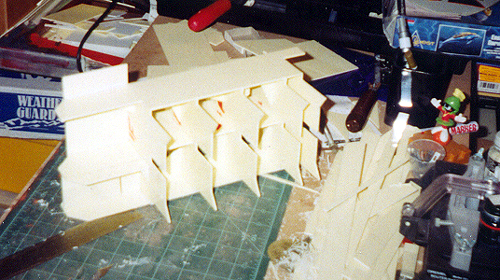 |
|
I actually started construction sometime in 1997. The first thing was to produce drawings of the Edmond Dantes.
The first problem to overcome was scaling. My wife to the
rescue, she had bought some shampoo, whose cap was the perfect shape for what
I assume to be the bridge dome seen on the novel cover. This piece is about
2" in diameter, which then roughly scaled the rest of the ship. The end result
will be a model a little over 4 feet long. (This may also be a contributing factor
to why it is not finished after 6 years, as my wife has stated that this model will not be displayed in any of the
living spaces in the house, especially hung from the ceiling.)
|
| |
|
|
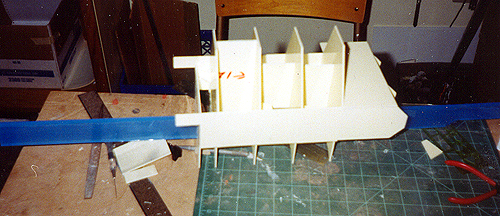 |
|
With only that one 3-D image to go by, I completed the drawings with quite a few "well that looks
right" compromises. The drawings were relatively simple; no details besides basic hull shape to clutter the
drawings Thus, I could add detail as desired. As well, wherever possible, the measurements were kept for the most part to the nearest 1/16".
|
| |
|
|
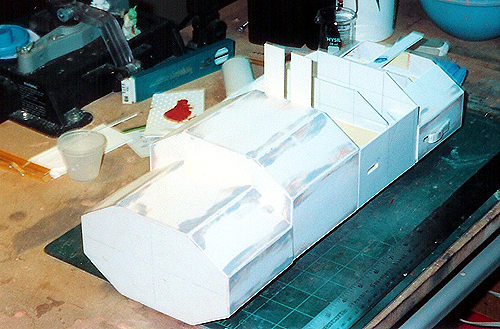 |
|
I progressed rapidly from there, finishing the main superstructure and engine housing. I connected the two with a 3/8” by 1-1/2"
Plexiglas beam that extended out to the front end. However, the whole thing came to a grinding halt when a friend (thanks VAUGHN!!!!) suggested that something as big as the Dantes should be lit. 'How was I going to run wire to the back end
now that it was built?', 'What was the back end going to look like?', and other nagging questions stopped the construction.
|
| |
|
|
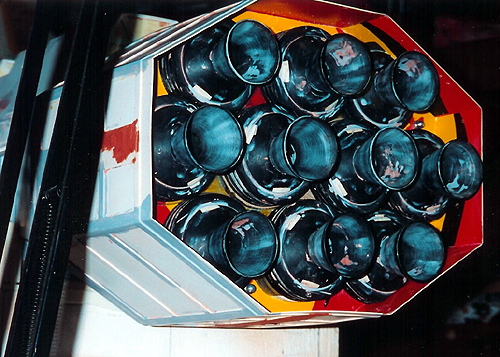 |
|
The Edmond Dantes sat on the floor until about January, 2001 when inspiration for the engines
struck:
I had tossed out several ideas for the engines. However, as chance would have it, I came into the possession of the remains of several
bathythermograph probes, which are used on naval ships to measure the speed of sound in water with depth. By measuring the
speed of sound versus depth, a ship can better use its sonar equipment. The probe is released from the side of a ship and in
order to get the speed-readings, a thin wire connects it to the measurement equipment. When the wire finally breaks, the
spindle is thrown away. All this to say that I had found the perfect engine solution for the Dantes.
|
| |
|
|
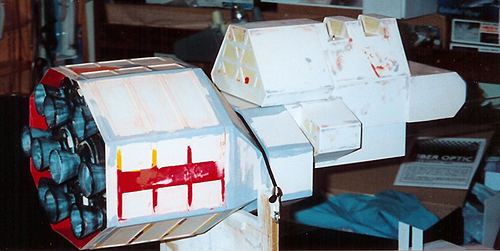 |
|
The spindles required modification, as I did not want the engine bell to stick out about 5 inches from the back. I cut the
spindle at the base and drilled a hole large enough to allow the insertion of the spindle. This will allow a depth to the
engine when the lighting is installed.
The back engine plate was formed from several layers of 1/4" Plexiglas
allowing for an offsetting of the engine bells.
|
| |
|
|
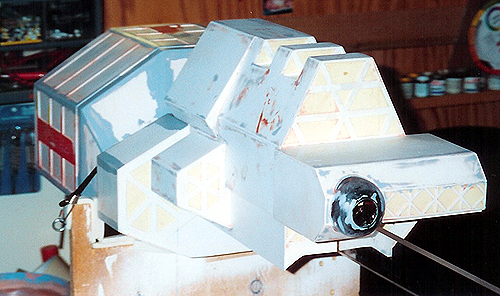 |
|
At the same time I was developing the idea for the engine, I put a second layer of styrene on the previous construction to
allow an overhang along the edges as well as hiding some truly gruesome joints. I also constructed the cargo pods that hang
below the forward superstructure. For this I intend to have the two pods directly below the superstructure removable
allowing access to the electronics and battery pack. I’ve installed a push-button switch in an "industrial" area of the
ship. It will be hidden amongst the detail when finished.
Construction has halted yet again due to a move to Ottawa from
Nova Scotia, and other ongoing projects.
|
| |
|
|
|
Photos
by Bill E.
|
|
|
|